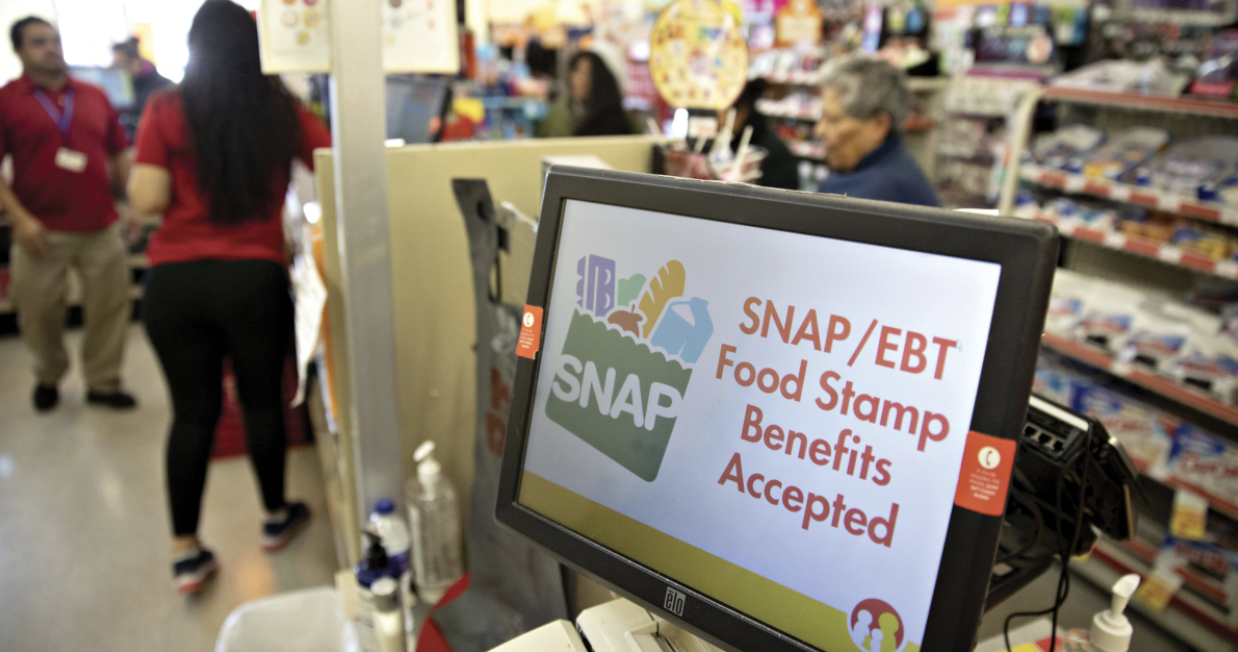Photo via Daniel Acker/Bloomberg/Getty Images
***
On Wednesday, November 12th, 2025, the longest U.S. government shutdown in history came to a close. President Donald J. Trump signed a bill aimed at resolving funding disputes between Democrats and Republicans, but the shutdown’s lingering effects remain unresolved. One of the shutdown’s most striking consequences was the defunding of the Supplemental Nutrition Assistance Program, or SNAP, better known as food stamps.
On October 10th, the United States Department of Agriculture (USDA) distributed a letter informing states that, due to a funding pause, SNAP funds would not be replenished for November. This decision left an estimated 42 million Americans questioning where their next meals would come from.
With a lack of federal programming, various states found themselves assuming responsibility for financing their residents’ next meals. New York Governor Kathy Hochul declared a state of emergency, announcing $30 million in emergency funds for food assistance and mobilizing the State University of New York Empire State Service Corps for support at food banks. At a judicial level, Bostonian Judge Indira Talwani proposed alternate methods of reducing benefits rather than total suspension. In a group effort by several Democratic governors and attorneys from nearly two dozen states, the USDA was sued for its handling of the situation, arguing that Congress’ emergency funds could partially supplement SNAP funds.
Now that Democrats and Republicans have reached some semblance of a compromise, SNAP benefits are expected to resume in full. In theory, the shutdown’s impact on SNAP is mostly resolved, but in reality, the situation remains complicated.
While benefits will resume, the timeline for this restoration is vague and varies across states. According to Propel, a software program designed to track SNAP distribution, as of Thursday, 3.8 million households are still missing their benefits and only about five million families have received partial benefits. Lack of transparency is always a problem when communicating to the public, but it is especially detrimental as recipients scramble to find food for their families.
The deal to end the shutdown has other provisions that could prove problematic in the near future. Under the legislation, Democrats and Republicans agreed to finalize only three bills each year to sustain funding for federal programs, including farm assistance, veterans services and food aid to dependent Americans. These bills account for only 10 percent of approximately $1.8 trillion in congressional funding, leaving the remaining funding to be temporarily allocated until Jan. 30. Despite the bill’s initial provisions to protect food aid, the looming threat of another shutdown could cause another pause in funding for the SNAP program.
This back-and-forth is not only unsustainable but also detrimental to Americans’ trust in their political institutions. The shutdown’s 43-day period was the most prolonged halt in SNAP’s history, challenging the long-held American assumption that the federal government would always provide for its citizens first. Feelings of instability and distrust were only amplified by Trump’s initial promise to reduce Democrat-backed public benefit programs and his refusal to tap into congressional funds during the pause.
If the past month has delivered anything to Americans, it is the message that federal safety nets—once thought of as a reliable social fallback—are constantly under threat by the Trump administration. In his notorious One Big Beautiful Bill Act of 2025, several provisions are proposed that would slash approximately $187 billion in SNAP funding, which was signed into law this past July. On Truth Social, Trump perpetuated the narrative that SNAP benefits are “haphazardly ‘handed’ to anyone for the asking, as opposed to just those in need,” and that “radical left Democrats” take advantage of the program.
The legislation that ended the shutdown acts as a band-aid rather than a satisfying solution, treating working-class individuals as political pawns rather than American citizens worthy of federal protection.
As SNAP beneficiaries navigate the gap between institutional promises and complete restoration, several community-based organizations across the country have stepped up to supplement the inadequate social protection provided by the Trump administration.
In Seattle, grocery store owners are offering customers up to $25 in free groceries, funding the endeavor through local donations. In the Bronx, initiatives such as Rise and Root Farm, distribute fresh produce weekly and operate community gardens that provide locals access to nutrient-dense food. Across the Brooklyn Bridge in Bedford-Stuyvesant, restaurants like Je T’aime Patisserie are offering complimentary breakfast to those who show their SNAP or EBT cards. A few hours away in Massachusetts, food pantries rely on community donations and volunteers to meet the needs of their residents.
The overwhelming response to these initiatives represents the importance of community involvement. When federal institutions are sidetracked by deliberation and party politics, it is local movements and grassroots organizations that help ensure community needs are met. SNAP will continue as a topic of uncertainty in the coming months, and keeping communities fed will be a persistent challenge, relying on relentless social action to keep America’s families fed.
***
This article was edited by Sinhawe Haji and Georgie Javier.
